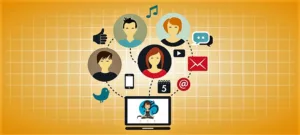Social Media of any brand plays a crucial role in driving traffic to any website. Social media apps are installed on every phone, while a site’s address is not in many bookmarks often.
Links shared on social media which lead to other websites are the main source of traffic for any website. This is why it is no wonder that advertisements on platforms like Facebook and Instagram are the first step any small business takes to gain a following.
Social media allows a new kind of engagement which was priorly unknown to those who only had websites for their business. Social media has paved the way for interaction between brands and users, gaining popularity, keeping a track of what the competitors are doing, receiving feedback, and much more.
Websites like docprime have utilized social media platforms like Facebook and Twitter to drive traffic to their website and introduce visitors to its benefits and turned them into potential users.
There are several ways in which a brand can engage effectively with its audience on social media platforms and drive them to their website. These go beyond the basics which only entertain the audience, such as using infographics and more visual content than textual, or posting every day and trying to improve engagement rates.
It is imperative to optimize one’s website so that search engines can catch it, and the content on all places- one’s website or social media- should be easy to share. But marketing is not limited to this. The following marketing techniques take into consideration the various tactics of marketing and decipher the complex mechanisms of user behavior and SEO together.
Influencer Marketing
Influencers are social media celebrities; they have huge followings and the ability to influence all of them. They are able to make such a huge impact because they provide people with a support or hope, they connect with their audience by appealing to their emotions, and relate to them in ways which satiate them. Truly, influencers are people who have marketed themselves well but authentically, which is why they now have such a huge influence.
As a result, social media influencers often get approached by brands to market them as well. This works very well due to the emotional appeal of these celebrity-like figures. People follow them religiously and trust them wholeheartedly, which is why if they promote a brand, people are certainly going to believe in the brand too.
Collaborating with influencers or brands, therefore allow anyone’s reach to multiply, as people who would otherwise miss their content also get to see it, and those interested will certainly follow.
Ephemeral Content
Ephemeral content is content that only lasts for a specific period of time. Often, one would think that this is a nightmare for any marketer, but that is where they are wrong. Snapchat stories and Instagram Lives receive millions of views within 24 hours, while the same influencers or brands might not get as many likes on a post.
This is because of the simple psychological trick that has been employed by brands throughout history- by making people think something will only last for a specific period of time, they create a need which might not be present otherwise.
This is how brands make customer purchase another pair of blue jeans by calling it ‘limited edition’ when they already have at least 2 pairs which look almost identical. Similarly, ephemeral content reached an audience since it will only last for so long. And if one is afraid that their content will then be lost, they must remember, ‘nothing is ever truly lost on the internet’.’
Social Listening
Social listening tools are plenty, and now they are also relatively cheap. What these tools let a brand do is receive information about all places they are being mentioned regardless of if they are tagged or not, regardless of if those mentioning them are following them or not.
Brands can also notice what are they mentioned in the context of, and if they are being searched for for specific products or services.
These tools also allow brands to respond to customers or potential buyers directly, even when they are not tagged, and thereby increasing their chances of receiving the trust of their audience.
Content generated by users
Users often create content that is original and creative, and of course influenced by a brand, event, topic, etcetera. If this content is used by brands for their publicity and marketing there is a higher chance of the audience being interested since they feel connected and acknowledged.
This might seem unimportant or un-impactful at first, but research has shown how effective these tactics are, so much so, that in the year 2005, TIME magazine named ‘You’ as the person of the years due to the rise of User-generated content on the internet.
Marketing through messenger
This is the last step to marketing effectively, while many may be wary of it due to its uncanny similarities to emails and SMSs sent for marketing which is annoying to all those who receive them, and often do not see the light of day as they get filtered and thrown into the spam folder every single time.
Messenger marketing is different: it is actually effective. Messenger, DMs, and other personal platforms for texting people have been seen to boost sales due to the high ‘open’ or ‘viewed’ rates, as well as high click-through rates. Moreover, most doctor platforms allow senders of messages to see if their messages have been seen by the receiver, which is a quick way to notice how people are responding to them without using any other tools.
These tricks make every business bloom since they allow brands to connect with their audience, which is the essence of good marketing. A marketing strategy that takes these into account is going to make the best of social media, and utilize all the tools that come with it.
Social media is the space where users spend most of their time virtually. The safety and comfort that they experience on social media platforms enable them to trust a brand. They feel responsible and also hold the brand accountable. All of this together makes the experience of a user much better, and a brand always benefits if the customers are happy. After all, there is no marketing tool as efficient as a satisfied customer.








